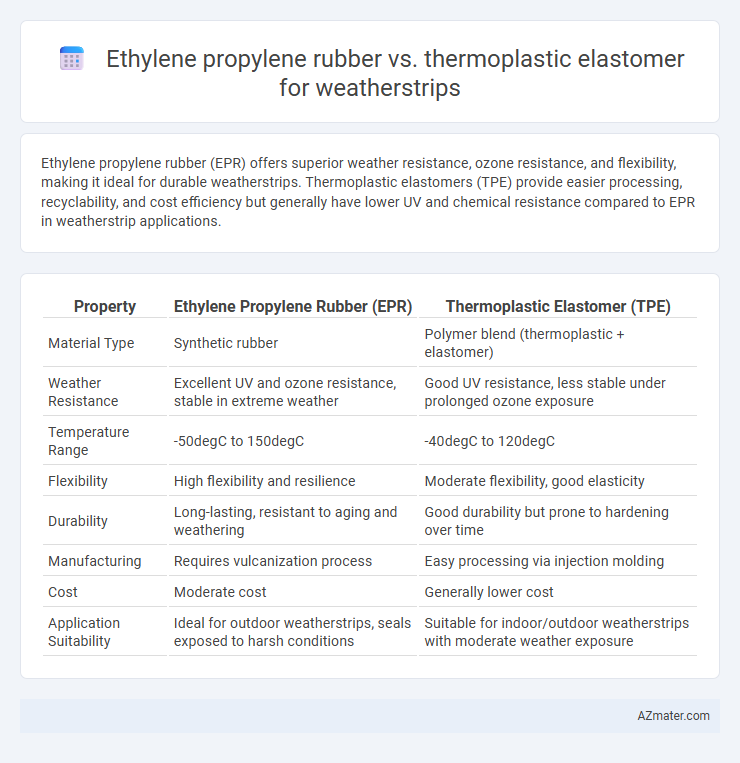Ethylene propylene rubber (EPR) offers superior weather resistance, ozone resistance, and flexibility, making it ideal for durable weatherstrips. Thermoplastic elastomers (TPE) provide easier processing, recyclability, and cost efficiency but generally have lower UV and chemical resistance compared to EPR in weatherstrip applications.
Table of Comparison
| Property | Ethylene Propylene Rubber (EPR) | Thermoplastic Elastomer (TPE) |
|---|---|---|
| Material Type | Synthetic rubber | Polymer blend (thermoplastic + elastomer) |
| Weather Resistance | Excellent UV and ozone resistance, stable in extreme weather | Good UV resistance, less stable under prolonged ozone exposure |
| Temperature Range | -50degC to 150degC | -40degC to 120degC |
| Flexibility | High flexibility and resilience | Moderate flexibility, good elasticity |
| Durability | Long-lasting, resistant to aging and weathering | Good durability but prone to hardening over time |
| Manufacturing | Requires vulcanization process | Easy processing via injection molding |
| Cost | Moderate cost | Generally lower cost |
| Application Suitability | Ideal for outdoor weatherstrips, seals exposed to harsh conditions | Suitable for indoor/outdoor weatherstrips with moderate weather exposure |
Introduction: Choosing the Right Material for Weatherstrips
Ethylene propylene rubber (EPR) offers superior resistance to heat, ozone, and weathering, making it highly effective for durable weatherstrips in extreme outdoor conditions. Thermoplastic elastomers (TPE) provide flexibility, easier processing, and recyclability, ideal for applications requiring cost-efficient manufacturing and environmental sustainability. Selecting between EPR and TPE depends on balancing long-term weather resistance with production needs and environmental impact for optimal weatherstrip performance.
Overview of Ethylene Propylene Rubber (EPR/EPDM)
Ethylene Propylene Rubber (EPR/EPDM) is a synthetic elastomer known for exceptional weather, ozone, and UV resistance, making it ideal for weatherstrip applications in automotive and construction industries. Its excellent flexibility at both high and low temperatures ensures durable sealing performance against water, dust, and air infiltration. Compared to Thermoplastic Elastomers (TPE), EPDM offers superior long-term stability and chemical resistance, enhancing its reliability in harsh environmental conditions.
Introduction to Thermoplastic Elastomers (TPEs)
Thermoplastic elastomers (TPEs) combine the elasticity of rubber with the processing advantages of plastics, making them ideal for weatherstrip applications requiring durability and flexibility. Unlike ethylene propylene rubber, TPEs can be melted and reshaped multiple times, enabling efficient manufacturing and recycling. Their resistance to UV radiation, ozone, and varying temperatures enhances the longevity and performance of weatherstrips in automotive and construction industries.
Key Material Properties: EPDM vs TPE
EPDM (Ethylene Propylene Diene Monomer) offers excellent resistance to ozone, UV radiation, and extreme temperatures, making it highly durable for weatherstripping applications exposed to harsh environments. TPE (Thermoplastic Elastomer) provides superior flexibility and easier recyclability, with good resistance to abrasion and chemicals, but generally lower UV and ozone resistance compared to EPDM. The choice between EPDM and TPE hinges on the required balance between environmental resilience and manufacturing efficiency for weatherstrips.
Weather Resistance Comparison: EPDM vs TPE
Ethylene propylene rubber (EPDM) exhibits superior weather resistance compared to thermoplastic elastomers (TPE), making it ideal for weatherstripping exposed to harsh environmental conditions such as UV radiation, ozone, and extreme temperatures. EPDM maintains elasticity and durability over long periods without cracking or degrading, whereas TPEs may experience faster aging and reduced performance under prolonged sun exposure. For applications demanding high weather durability, EPDM's chemical structure provides enhanced resistance against oxidation and hydrolysis, outperforming most TPE formulations in outdoor weatherstrip sealing solutions.
Flexibility and Durability in Weatherstrip Applications
Ethylene propylene rubber (EPR) offers superior flexibility and excellent weather resistance, making it ideal for weatherstrip applications exposed to extreme temperatures and UV radiation. Thermoplastic elastomers (TPE) provide good flexibility and are easier to process but may show reduced long-term durability under continuous outdoor exposure. EPR typically delivers enhanced resistance to ozone, aging, and harsh environmental conditions, ensuring longer lifespan and consistent sealing performance in weatherstripping uses.
Manufacturing Process Differences
Ethylene propylene rubber (EPR) is typically manufactured through a vulcanization process involving sulfur or peroxide curing, which enhances its elasticity and durability for weatherstrip applications. Thermoplastic elastomers (TPEs), on the other hand, are processed using conventional thermoplastic methods such as injection molding or extrusion, which allow for easier recyclability and faster production cycles. The key manufacturing difference lies in EPR's cross-linking during vulcanization, compared to the physical melting and solidifying behavior of TPEs, impacting both production scalability and end-use performance.
Cost Considerations: EPDM vs TPE Weatherstrips
Ethylene propylene rubber (EPDM) weatherstrips generally offer lower raw material costs and superior resistance to UV, ozone, and extreme temperatures, resulting in longer service life and reduced replacement frequency. Thermoplastic elastomers (TPE) present higher upfront material costs but enable easier recycling and faster manufacturing through injection molding, which can lower labor and production expenses. Evaluating total lifecycle costs, EPDM is often more cost-effective for outdoor and long-term applications, while TPE may provide savings in high-volume, short-cycle production environments.
Sustainability and Environmental Impact
Ethylene propylene rubber (EPR) offers excellent weather resistance and durability, making it a long-lasting option that reduces waste over time, while its manufacturing process involves fewer toxic emissions compared to some synthetic rubbers. Thermoplastic elastomers (TPEs) are recyclable, supporting circular economy initiatives by allowing reused materials to reduce landfill impact and energy consumption during production. Both materials have distinct environmental advantages, with EPR excelling in longevity and reduced emissions, and TPEs contributing through recyclability and lower carbon footprints in end-of-life processing.
Conclusion: Selecting the Optimal Weatherstrip Material
Ethylene propylene rubber (EPR) offers superior weather resistance, excellent UV and ozone stability, and long-term durability, making it ideal for harsh environmental conditions in weatherstripping applications. Thermoplastic elastomers (TPEs) provide greater flexibility, ease of fabrication, and recyclable properties, but typically have lower resistance to prolonged UV exposure and chemical degradation. Selecting the optimal weatherstrip material depends on prioritizing performance factors such as environmental resilience and longevity, where EPR excels, versus cost-effectiveness and recyclability, favoring TPEs.

Infographic: Ethylene propylene rubber vs Thermoplastic elastomer for Weatherstrip
 azmater.com
azmater.com